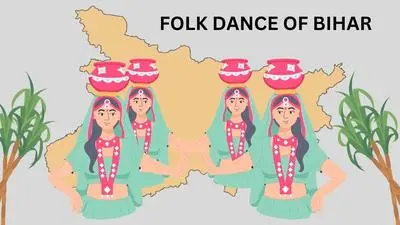10 Famous Folk Dances in Andhra Pradesh | Classical AP Dances
Pinkey Sharma |
Dance |
2024-12-07 |
null mins read

Table of Contents
- List of Folk Dances of Andhra Pradesh
- 1. The Kuchipudi dance
- 2. Lambadi Dance
- 3. Bonalu Dance
- 4. Butta, Bommalu
- 5. Bhamakalpam Dance
- 6. Gollakalpam
- 7. Kalapam Dance
- 8. Veeranatyam
- 9. Dhimsa Dance
- 10. The Bathakamma Dance
- The Importance of Folk Dances in Andhra Pradesh
- How to Explore and Learn More About Andhra Pradesh’s Folk Dances
- Some More Related Blogs:
- Wrapping Up
- Frequently Asked Questions (FAQs)
Andhra Pradesh is a state famous for its different traditions and rich cultural tapestry. It also has a lot of lively folk dances that show what the people there believe and how they live. From the rhythmic footwork of Kuchipudi to the joyous moves of Lambadi, the folk dances of Andhra Pradesh offer a unique glimpse into the heart of its culture. These dances are more than just shows; they're a way for people to show their love, celebrate, and support each other. Each dance has its own meaning and beauty, whether it is done at a holiday, during harvest time, or at a religious ceremony.
This article will show you 10 famous folk dances from Andhra Pradesh and explain their background, style, and cultural meaning. Whether you love dance or are just interested in Indian culture, these dances will capture your attention with their energy, beauty, and vivid stories. Let's dive into the world of music, dance, and custom and learn about the beautiful folk dances of Andhra Pradesh!
List of Folk Dances of Andhra Pradesh
Given Below is the list of some of the famous folk Dances of Andhra Pradesh:-
|
Dance |
Brief |
|
Kuchipudi Dance |
Classical dance with graceful movements, expressive storytelling, and footwork, rooted in Hindu mythology. |
|
Lambadi Dance |
Tribal dance of the Banjara community, featuring colorful costumes and expressive hand gestures. |
|
Bonalu Dance |
Performed during the Bonalu festival, with dancers carrying pots on their heads as offerings to Goddess Mahakali. |
|
Butta Bommalu |
Mask dance representing mythological characters, performed during harvest festivals. |
|
Bhamakalpam |
Devotional temples dance with energetic movements to honor Goddess Bhamakalamma. |
|
Gollkalpam |
Community dance performed during festivals with rhythmic footwork and folk music. |
|
Kalapam |
Sacred dance performed in temples, telling divine stories through movements and prayers. |
|
Veeranatyam |
Warrior's dance honoring Veerabhadra, with powerful, martial arts-inspired movements. |
|
Dhimsa Dance |
Tribal dance with synchronized movements symbolizing nature's rhythms. |
|
Bathakamma Dance |
Performed during the Bathakamma festival, dancing in circles with flowers, symbolizing the cycle of life. |
1. The Kuchipudi dance
One type of traditional dance that comes from Andhra Pradesh is Kuchipudi (in Telugu: కుచిపూడి నృత్యం). It is a very stylized and traditional type of dance drama that is known for its graceful movements and moving stories. The name "Kuchipudi" comes from the village of the same name in the Krishna state of Andhra Pradesh.
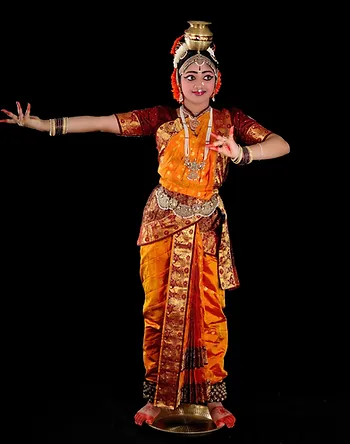
Origin and History
In the beginning, Kuchipudi was done in temples as a religious rite. It was built in the 2nd century BCE, and the great teacher Siddhendra Yogi is thought to have made it. The dance has graceful moves, rhythmic footwork, and complicated hand gestures that are often used to tell stories from Hindu folklore. It changed over time into a sort of stage performance, but it still has a classical feel to it.
How to Perform (Steps for How to Do the Dance)
In Kuchipudi, dancers use complex footwork, fast spins, and detailed hand motions to show how they feel. The artist usually wears a traditional saree, which makes it easy for her to move around. The dance starts with a prayer or call to the gods, and then there is a long series of dances that tell a story. The most important parts of Kuchipudi are:
-
Nritta: Pure dance moves that are all about beat.
-
Abhinaya: Facial movements that show how you feel.
-
Nritya is a dance style that uses music and expression to tell a story.
Performers often use balancing moves, like walking on the edge of a metal plate, to show how dedicated and disciplined they are to their art.
Musical instrument Used in Kuchipudi
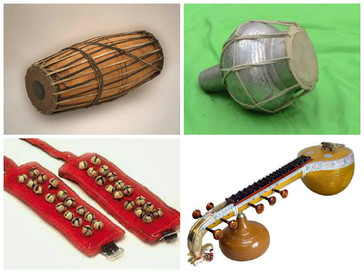
Instruments like the mridangam (a percussion instrument), the violin, the flute, and the tambura are often used to make music for Kuchipudi shows. The vocalist's job is also very important because they help the dancer keep up with the beat and mood with their singing.
Fun Facts:
-
One of India's oldest classical dance traditions, kuchipudi is well-known worldwide and has been performed all over the world.
-
Kuchipudi offers a range of storytelling methods and may be done both solo and in groups, unlike many other traditional dances.
-
The dance involves a special "water dance," in which the dancer uses complex footwork to balance a brass plate loaded with water on their head.
Importance for Kids
Kuchipudi is good for kids in many ways. It helps them learn to be patient, disciplined, and coordinated. A lot of the time, kids who learn Kuchipudi learn a lot about Indian art, society, and mythology. It also helps you get in shape because of the complicated footwork and body moves.
2. Lambadi Dance
The nomadic Lambadi people in Andhra Pradesh are linked to the Lambadi dance(in Telugu: లంబాడీ నృత్యం) (also known as the Banjara group). People dance this way to show their happiness, and they do it at fairs, weddings, and other social events.
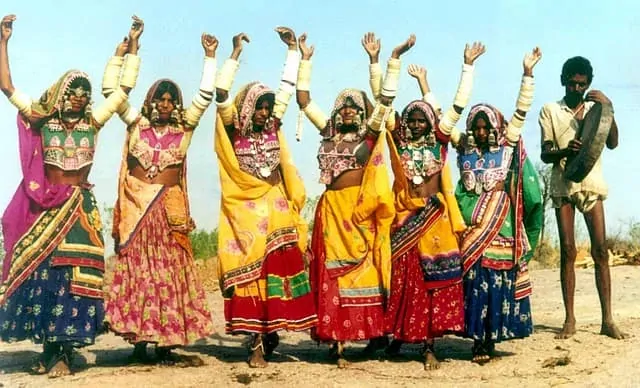
Origin and History
The Banjara tribes created the Lambadi dance. These people were known for living a lively and bright life. In the beginning, the women would use music and movement to tell stories about their daily lives, including their happiness and sadness. It became an important part of their culture celebrations over time.
How to Perform (Steps for How to Do the Dance)
People start the lambadi dance for hitting their feet in time and moving their bodies quickly. Most of the time, the dancers move in a circle or a line to the beat of the music. The women dance by clapping, spinning, and moving their hips to the beat. Claps and steps are played along with the dance, and as the dancers spin and move, they often make a pattern.
Musical instrument Used

The beats of the dholak (a type of drum), the nadaswaram (a wind instrument), and the flute make up the music of the Lambadi dance. The fast beats of these instruments keep the dance's pace lively and energizing.
Fun Facts:
-
The Banjara or Lambadi tribe, who are renowned for their colorful clothes and nomadic way of life, is the origin of the Lambadi dance.
-
The expressive hand gestures used in the dance depict a wide range of emotions, including joy, love, and grief.
-
Mirrors that sparkle in the sunlight adorn the Lambadi dancers' traditional attire, symbolizing the tribe's rich cultural legacy.
Importance for Kids
The Lambadi dance helps kids learn rhythm, balance, and how to show their feelings. Fast-paced dance helps kids get more agile, and it's also a way for them to learn about the practices and customs of the Banjara people.
3. Bonalu Dance
The Bonalu festival in Andhra Pradesh, especially in the Telangana area, is known for the Bonalu dance(in Telugu: బొనాలు నృత్యం). That is done to respect the goddess Mahakali and show appreciation for her protection and blessings.
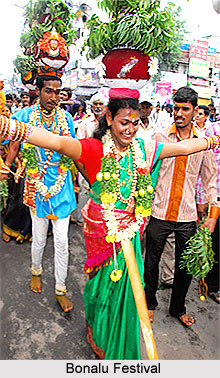
Origin and History:-
Back in the 1800s, when the Nizam of Hyderabad was in charge, the Bonalu holiday began. As part of the custom, people give the goddess rice, jaggery, and curd. The dance is done by women as part of the holiday celebrations, which take place in temples to Mahakali.
How to Perform (Steps for How to Do the Dance)
Strong, circular moves are what make the Bonalu dance unique. Women dancers often wear traditional clothes and carry pots on their heads, which are called "Bonalu." Swaying, hopping, and dancing in a circle while holding the pot are some of the steps. There are religious songs sung by the dancers, which makes the show emotional and spiritual.
Musical instrument Used
Traditional drumming, with instruments like the dholak and drums, goes along with Bonalu dance. There is a sense of urgency and devotion during the show because the beat is fast and intense.
Fun Facts:
-
During the Bonalu festival, Bonalu is performed to thank Goddess Mahakali, express gratitude for a bountiful crop, and safeguard the community.
-
As a symbolic offering to the goddess, the dancers hold adorned pots on their heads, signifying her benefits.
-
Because of its regional variances, Bonalu is a vibrant and varied celebration, with each region contributing its unique flair to the performance.
Importance for Kids
The Bonalu dance is a show of loyalty and faith. For kids, it teaches them to be thankful, be a part of their community, and respect traditions. Through the beats and movements of this dance, kids can also learn about the rich culture of Andhra Pradesh.
4. Butta, Bommalu
Butta Bommalu(in Telugu: బుట్ట బొమ్మలు) is a traditional dance style in Andhra Pradesh that is done at festivals and other happy events. Small dolls or figures made by hand are used in the dance. They are called "Butta Bommalu."
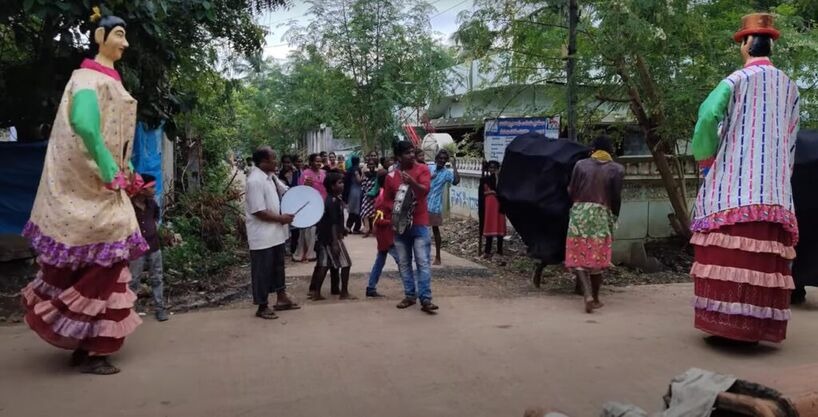
Origin and History:-
The tribal culture of Andhra Pradesh is linked to the history of Butta Bommalu. At first, it was done during harvest festivals to ask the gods for their blessing. Often, the dolls used in the dance are very detailed and look like different animals and gods.
How to Perform (Steps for How to Do the Dance)
Folk dancers wear traditional clothes and hold the Butta Bommalu in their hands while they dance. The dancers move and step in beautiful ways, and as they move, they often make rings or patterns. Folk songs play in the background, and the whole show is very lively and full of energy.
Musical instrument Used
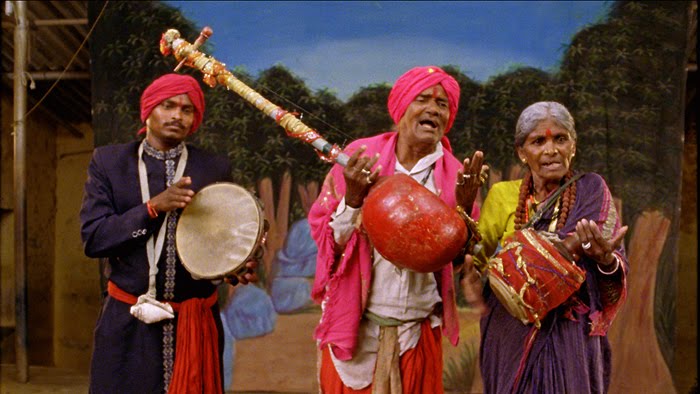
Instruments like the mridangam, flute, and tambura are often used to make music for this dance. As with the dance, the beats are quick and full of energy.
Fun Facts:
-
The use of ornamented masks worn by dancers to symbolize different mythological figures is among Butta Bommalu's most fascinating features.
-
It is thought to bring wealth and good fortune to the community and is performed at harvest festivities.
-
Butta Bommalu is closely associated with rituals, using symbolic movements and gestures to invoke divine benefits.
Importance for Kids
What a great chance for kids to learn about how important faith and custom are through Butta Bommalu. They learn about the cultural meaning of idols and get to enjoy the fun of community events.
5. Bhamakalpam Dance
This Bhamakalpam dance(in Telugu: భామకల్పం) combines elements of dance and drama. It is believed to have its origins in Kuchipudi dancing. This dance features delicate, feminine gestures. Sidhendra Yogi was the pioneer of the gollkalpam and bhamakalpam dances in the 17th century. It was designed to dissuade prostitutes from learning this dance technique. Males from the Brahmin community were chosen and trained in the dance. This dancing type has a distinct significance due to motions and facial expressions.
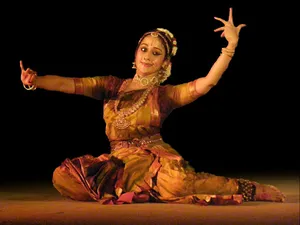
Origin and History:-
It is thought that Bhamakalpam began as a dance honoring the goddess Bhamakalpa, who is a fierce form of Durga. Women do the dance to ask the goddess to protect them and bless them. The tradition has been passed down from one family to the next.
How to Perform (Steps for How to Do the Dance)
Movements like stamping feet, hand gestures, and facial reactions that are timed to music show how dedicated the dancer is. A lot of the time, the performers move in circles to represent how life and loyalty go in cycles. The steps are slow and graceful, and deep prayers often play in the background.
Musical instrument Used
Temple music, which includes drums like the dholak and different wind instruments, is often played while Bhamakalpam is played. The rhythm helps make the environment trance-like, which makes you feel spiritually connected.
Fun Facts:
-
As a show of devotion to the goddess Bhamakalamma, temples perform the sacred dance known as Bhamakalpam.
-
The dance features strong intensity, with fast-paced movements expressing delight and appreciation to the goddess.
-
In order to represent the sacred bond between nature and the divinity, dancers occasionally don masks or imitate animals.
Importance for Kids
Bhamakalpam is a way for kids to learn about the religious and spiritual sides of folk dances. It helps them understand how important dance is in different cultures as a way to worship and show oneself.
6. Gollakalpam
Folk dancing from the agricultural parts of Andhra Pradesh is called gollakalpam(in Telugu: గోలకల్పం). Young women traditionally do this dance at festivals, especially in towns out in the country. Traditional songs are often sung along with the dance, which makes it both an art form and a celebration of life in the country.
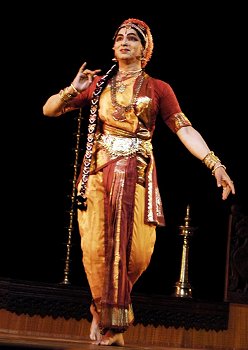
Origin and History:-
The agricultural culture of Andhra Pradesh is linked to the history of Gollakalpam. This is something that people in rural areas have always done during harvest parties and other celebrations. People think that the dance was made to thank the gods for a good crop and to make sure that the land would continue to be prosperous.
How to Perform (Steps for How to Do the Dance)
Most of the time, women form a circle or line to do gollakalpam. The dancers sway to the beat of the music and move in a regular pattern. Stepping to the beat, clapping your hands, and using your hands to tell a story are the main actions. They are soft and flowing, just like village life, which is calm and peaceful. The dancers also show how happy and content they are with a good harvest with their faces.
Musical instrument Used
Traditional instruments like the dholak (a type of drum), drums, and the harmonium are often played to go with the dance. There are slow, soothing beats that go with the dance's gentle moves.
Fun Facts
-
Gollkalpam is customarily done during community festivals and village fairs to commemorate the harvest and ask for blessings for a prosperous future.
-
Folk instruments like the flute, nadaswaram, and dholak are used to accompany the dance, which creates a vibrant environment.
-
The rapid and vivacious step represents the lively vitality of country living.
Importance for Kids
Gollakalpam helps kids understand how simple and beautiful life can be in the country. It teaches them how important events are for keeping cultural ties alive and how to take care of nature. Kids learn how much fun it is to work together as a group and how good it feels to celebrate life's little pleasures through this dance.
7. Kalapam Dance
Kalapam(in Telugu: కలాపం) is a folk dance that is done during the holiday of Sankranti in Andhra Pradesh, which marks the start of harvest season. It is a dance for celebration that is done in groups, mostly by women, and has rhythmic moves.

Origin and History:-
Kalapam has been around for a very long time and has deep roots in the rural customs of Andhra Pradesh. The dance is part of the bigger celebrations for Sankranti, a holiday that farmers use to mark the beginning of a new farming season and the harvest. The dance shows happiness and thanks for the harvest and the land's ability to grow crops.
How to Perform (Steps for How to Do the Dance)
Kalapam is done by groups of dancers who make a circle or half-circle. The dancers move in time with the music, clapping their hands and kicking their feet together a lot of the time. The dance moves are lively and have a lot of complicated hand and foot movements. Folk songs are chanted by the artists while they dance, which makes the mood even better.
Musical instrument Used
Traditional instruments like the dholak, drum, and flute play in the background of the dance. The fast-paced rhythm shows how exciting and lively the harvest event is. The beats help the dancers stay in time and add to the joyful mood.
Fun Facts:
-
Often accompanied by chanting and prayers, kalapam is a religious dance done during temple rites to worship gods and goddesses.
-
Performers tell divine tales through dance, frequently showing conflicts between gods and devils.
-
Dancers typically use bright, colorful clothes that symbolize devotion to the gods and purity.
Importance for Kids
Kalapam shows kids how important it is to be part of a community and how much fun it is to celebrate the harvest. In this dance, kids learn about the Sankranti holiday, farming, and how things in nature work in cycles. Dancing as a group also promotes working together and as a team.
8. Veeranatyam
Andhra Pradesh's Veeranatyam(in Telugu: వీరనాట్యం) is a traditional folk dance that is often done at religious events, especially in rural areas. It's a type of dance that tells stories through movement, generally about bravery, devotion to gods, and being a hero.
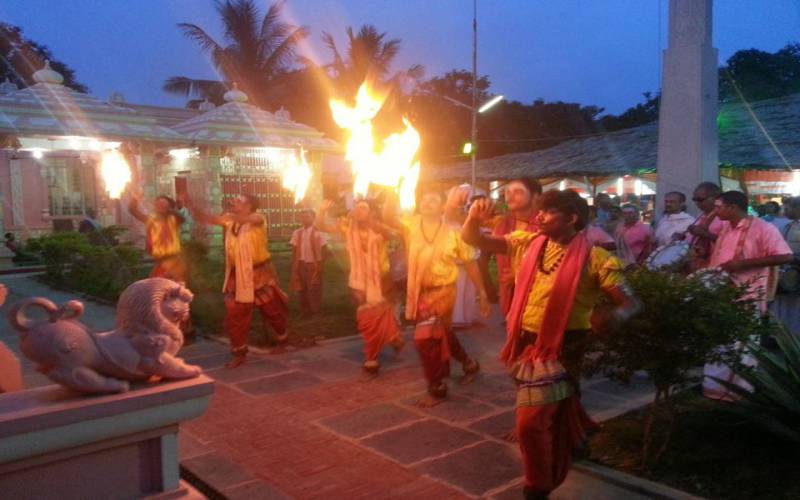
Origin and History:-
Ancient Andhra Pradesh is where Veeranatyam got its start. It was usually done in temples as part of religious ceremonies. At first, the dance was used to tell stories about the brave actions of fighters and kings. Over time, it changed into a form of spiritual and devotional dance.
How to Perform (Steps for How to Do the Dance)
Veeranatyam is usually done by men, who dress up as fighters with elaborate costumes and face paint. Strong dance moves with a lot of energy and dramatic gestures are used. To show how brave and heroic heroes are, the performers often do sword fighting moves that look like war scenes. During the breaks in the dance, the performer takes heroic poses and shows how they feel with their faces.
Musical instrument Used
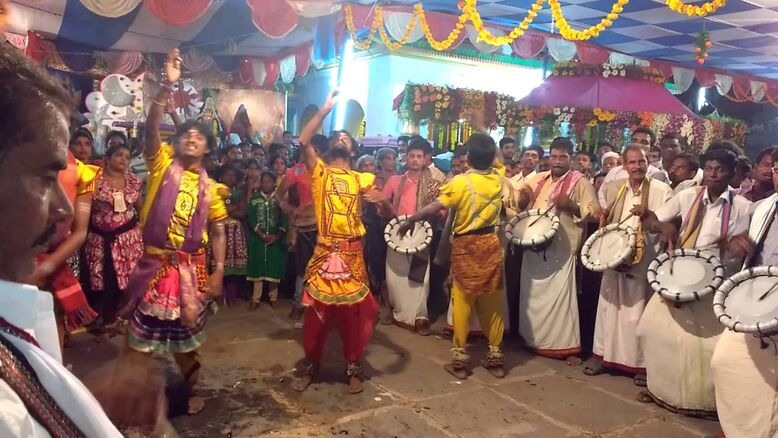
The dholak, chenda, and drums are usually used to make music for Veeranatyam. This show has a dramatic and intense feel because the beat is fast and full of energy.
Fun Facts:
-
Powerful and energizing, Veeranatyam is a warrior's dance performed in homage to the god Veerabhadra.
-
In order to portray bravery and strength, the dancers use ferocious facial expressions and moves reminiscent of martial arts.
-
The tambura and loud drums used in this dance's music heighten the performance's dramatic effect.
Importance for Kids
Veeranatyam teaches kids about the courage and honor of ancient heroes and warriors. In Indian society, it helps them understand how important bravery, honor, and loyalty are. Kids who learn Veeranatyam can also learn how important it is to keep historical stories alive through speaking and performance.
9. Dhimsa Dance
Some native groups in Andhra Pradesh, especially those in the Eastern Ghats, have been dancing the Dhimsa(in Telugu: ధిమ్సా నృత్యం) for a long time. It's done at festivals, especially ones that honor nature and the crop, and the dancers are known for moving in time with the music.
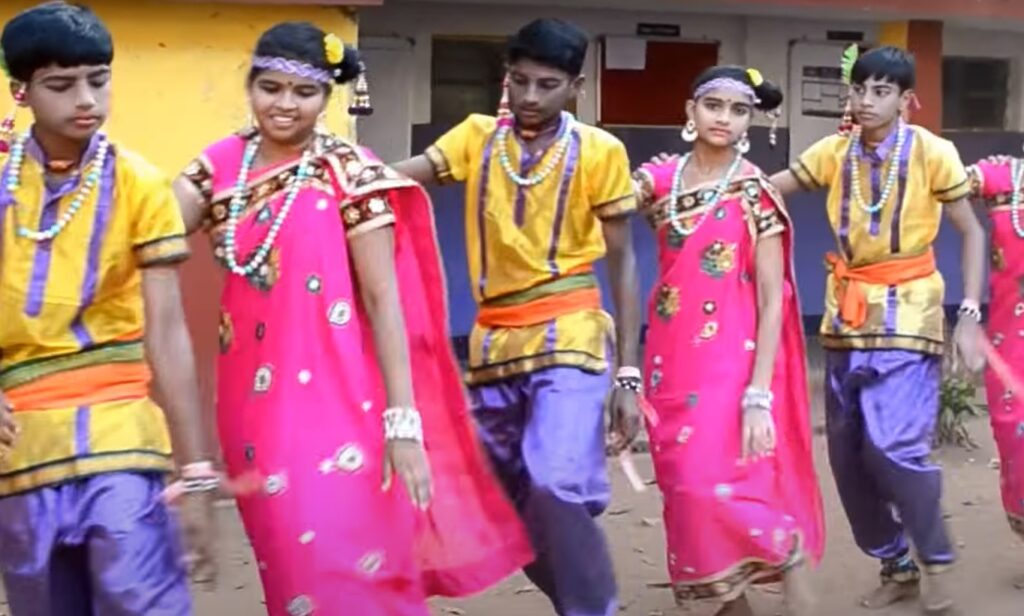
Origin and History:-
The dhimsa dance comes from the tribal groups in Andhra Pradesh, where it is practiced as part of many ceremonies and celebrations. The dance has a lot to do with how much the community values nature. It is often done at harvest events, when the tribal people get together to thank nature for the good crops.
How to Perform (Steps for How to Do the Dance)
Men and women both do the Dhimsa dance. They form a circle and move in time with each other. People clap their hands and stamp their feet together as they dance in a slow, regular way. The dancers' moves are very well coordinated, and they all copy each other perfectly. The dancers also show how happy they are about the harvest with their faces and hands.
Musical instrument Used
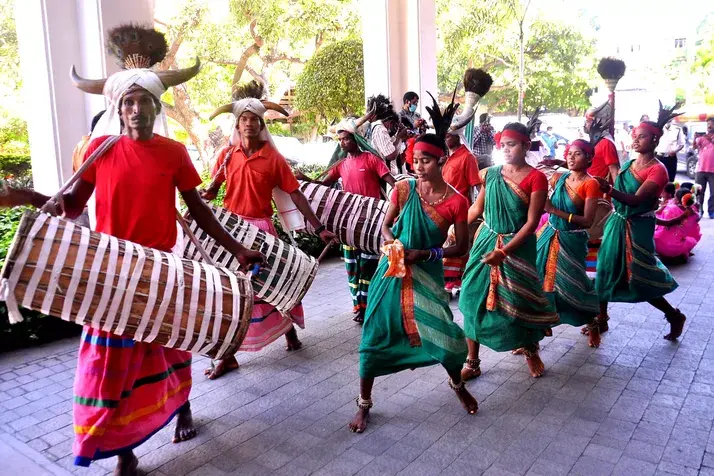
Musical instruments drums
Tribal instruments, such as drums like the dholak and other musical instruments, are played while the dhimsa dancers move. The dancers can stay in sync with each other because the beats are steady.
Fun Facts:
-
Andhra Pradesh's tribal groups perform the dhimsa dance, which represents their rich cultural legacy.
-
The dance's synchronized motions, in which every dancer moves in perfect unison, are one of its highlights and symbolize the tribe's unity.
-
By imitating the beat of natural elements like wind and rain, the dance's movements are symbolic of nature.
Importance for Kids
Dhimsa dance gives kids a chance to connect with nature and the traditional ways of the people of Andhra Pradesh. They learn how to celebrate nature's gifts through dance and how important it is to live in peace and society. Through this dance, kids also learn how important it is to have good rhythm and balance.
10. The Bathakamma Dance
During the Bathakamma event, which is held in Telangana and Andhra Pradesh, the Bathakamma dance(in Telugu: భతకమ్మ నృత్యం) is performed. The festival celebrates Bathakamma, the goddess of nature, fertility, and the harvest.
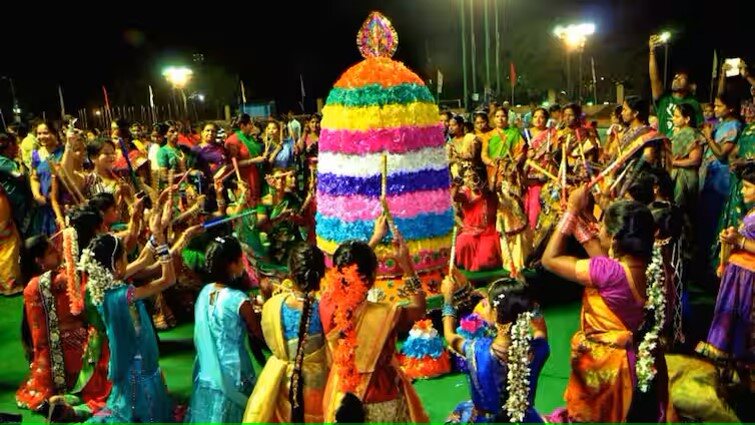
Bathakamma even
Origin and History:-
The Bathakamma dance is a part of the Bathakamma event, which is a celebration of the harvest and the start of the monsoon season. As part of the holiday honoring the goddess Bathakamma, women arrange flowers in a certain way and dance around the Bathakamma for the occasion.
How to Perform (Steps for How to Do the Dance)
Women do the Bathakamma dance. They form a circle and dance beautifully around a flower structure called the Bathakamma. The dance moves are slow, graceful, and rhythmic, and people often clap, spin, and swing. The dance is done in time with the folk songs that the people are singing, making the mood happy and lively.
Musical instrument Used
Folk music is played while the Bathakamma dance is done, and the dancers often sing along. The songs repeat and are easy to follow, which makes the dance even more regular. Simple percussion instruments, such as drums or dholak, are often played to go with the music.
Fun Facts:
-
During the Bathakamma festival, flowers are brought to the goddess in a pyramidal arrangement, and the Bathakamma dance is performed.
-
The dance is always done in a circle, signifying the life cycle and a link to the natural rhythms.
-
Women mostly perform it, and their traditional sarees and accessories enhance the dance's aesthetic appeal.
Importance for Kids
Children learn about the value of nature, holidays, and getting involved in their community through bathakamma dance. Kids learn about the Bathakamma festival through dance. The festival honors the goddess for making sure there is a good crop. The dance teaches kids to value flowers, nature, and the part women play in keeping cultural customs alive.
The Importance of Folk Dances in Andhra Pradesh
Folk dances in Andhra Pradesh are more than just an art form; they are an important part of the state's history and culture. People use these dances to show how they feel, enjoy holidays, and tell stories that have been passed down from generation to generation:
1. Keeping cultural heritage alive
Folk dances are an important part of Andhra Pradesh's rich culture history. They help keep living old customs by passing on rituals, practices, and stories that have been passed down from generation to generation.
2. Taking into account social beliefs and values
People's social ideals, beliefs, and way of life are often shown in these dances. From the dedication in Bhamakalpam to the joy of the harvest in Tappeta Dance, each dance shows how the community is connected to nature, religion, and everyday life.
3. Building stronger community ties
Folk dances are a big part of bringing people together. These dances bring people together, support unity, and celebrate a shared cultural identity. They are done at festivals, weddings, and other local events.
4. Having celebrations and religious ceremonies
A lot of folk dances are important to religious ceremonies and holidays. For example, the Bonalu Dance is for the Goddess Mahakali, and the Bathakamma Dance is for the Bathakamma festival. These dances are important ways to show faith, gratitude, and ethnic pride.
5. The telling of stories and the representation of myths
People tell stories through folk music. They usually show stories from mythology, historical events, or life in the country. This gives the viewer a rich visual story that ties them to the past.
6. Encouragement of Cultural Tourism
Folk dances are a big draw for tourists because people are becoming more interested in traditional art forms. Folk dance festivals in Andhra Pradesh bring people from all over the world, which helps the state's economy and culture tourism.
How to Explore and Learn More About Andhra Pradesh’s Folk Dances
There are many ways to get involved with Andhra Pradesh's rich dance traditions if you want to learn and dance folk dance. There are many ways to get involved with folk dance performances in Andhra Pradesh, whether you want to become a dancer or are just interested in the cultural depth of the shows.
1. See folk dance shows in Andhra Pradesh.
Going to folk dance events in Andhra Pradesh is one of the best ways to learn about the state's traditional dances. There, you can see some of the best traditional dancers perform. A lot of people get together to enjoy festivals like Ugadi, Bonalu, and Bathakamma, and folk dances are a big part of these events. At these events, you can see and hear the dances in their natural settings, with live music and bright costumes making it a cultural feast for the eyes and ears.
2. Join dance schools or academies in your area.
You can join dance schools and colleges in Andhra Pradesh that teach traditional dances and find out more about folk dance shows. In Andhra Pradesh, cities like Hyderabad, Vijayawada, and Visakhapatnam have dance schools that teach both formal and folk dance.
Kids learn not only how to dance, but also where the dances came from and what they mean. Going to these schools is a great way to find out more about the dances and how important they are to different places. You can learn Andhra Pradesh folk dance from anywhere in the world because many of these schools offer classes and training that you can do online.
3. Take part in workshops and events in your community.
A lot of places in Andhra Pradesh, both rural and urban, hold regular classes and events to keep traditional dance styles alive. Folk dance styles like Lambadi, Tappeta, and Gollkalpam can be learned directly from people who practise them in these community-based events.
A lot of the time, experienced dancers lead these classes, which anyone of any age or level of skill can join. This is a great chance to learn about the culture of the area and connect with the people who have been practicing these practices for years.
4. Find out about folk dances and read books or documentaries about them.
There are many books, study papers, and documentaries about the wide range of Andhra Pradesh's folk dances if you'd rather learn about them in a more theoretical way. These sources often talk about where each dance style came from, what it means historically, and what makes it special. You can also watch videos of folk dance performances in Andhra Pradesh online. These videos can help you understand the subtleties of the performances.
5. Go to museums and cultural centers.
Visit cultural centers and museums that show traditional art forms, like folk dances, to learn more about Andhra Pradesh's culture history. You can learn about the past and development of dance in the area through live performances and art shows that are often held in these places. You can talk to dance artists and experts and find out more about how different types of dance have changed over time.
Some More Related Blogs:
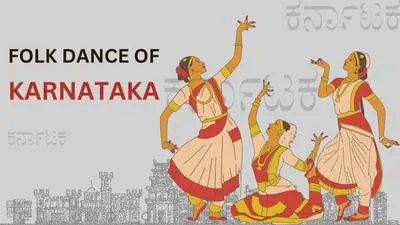 **Famous Folk Dance of Karnataka
**Famous Folk Dance of Karnataka
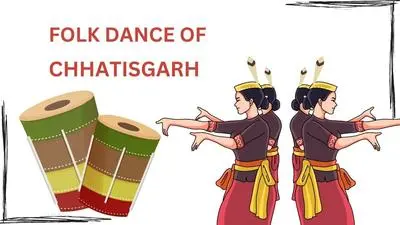 **Top 10 Folk Dance of Chhattisgarh
**Top 10 Folk Dance of Chhattisgarh
Wrapping Up
For people in Andhra Pradesh, folk dances are more than just shows; they show the state's spiritual views, long history, and rich culture. A lot of different dances are important to the state's culture because they all have their own style, history, and meaning. The graceful Kuchipudi, the lively Lambadi, and the spiritual Bhamakalpam are some of the dances that help protect Andhra Pradesh's traditional heritage and bring the people of the state together and make them feel proud. For kids, these dances show them how important tradition, society, and faith are in their daily lives.
Frequently Asked Questions (FAQs)
Q1: What does the Andhra Pradesh Kuchipudi dance mean?
Ans:- Kuchipudi is a traditional dance style from the state that shows off its rich cultural past. Hindu myths are often used as the basis for the dance, music, and acting. It's a big deal for people in Andhra Pradesh to show how hard they work and how good they are at art.
Q2: What is different about Lambadi dance from other types of folk dance?
Ans:- The people of Banjara do the Lambadi dance, which is known for its lively beat and bright clothes. Unlike many other folk dances, it is all about quick body and foot movements. This makes it lively and interesting to watch.
Q3: What is the main idea behind the Bonalu dance?
Ans:- Bonalu is a dance that is performed to honor the goddess Mahakali. Most of the time, women do it during the Bonalu holiday, when they pray and give thanks for being safe and blessed.
Q4: Why is Veeranatyam seen as a brave dance?
Ans:- This dance form called Veeranatyam shows how brave fighters and heroes really are. So, the dance is a celebration of bravery, strength, and commitment, with dramatic moves and heroic poses.
Q5: Why is learning old-fashioned country dances good for kids?
Ans:- Folk dances teach kids about national traditions, improve their body coordination, and teach them important lessons about how to work together, follow rules, and respect traditions.
Frequently Asked Questions
Kuchipudi is a traditional dance style from the state that shows off its rich cultural past. Hindu myths are often used as the basis for the dance, music, and acting. It's a big deal for people in Andhra Pradesh to show how hard they work and how good they are at art.
The people of Banjara do the Lambadi dance, which is known for its lively beat and bright clothes. Unlike many other folk dances, it is all about quick body and foot movements. This makes it lively and interesting to watch.
Bonalu is a dance that is performed to honor the goddess Mahakali. Most of the time, women do it during the Bonalu holiday, when they pray and give thanks for being safe and blessed.
This dance form called Veeranatyam shows how brave fighters and heroes really are. So, the dance is a celebration of bravery, strength, and commitment, with dramatic moves and heroic poses.
Folk dances teach kids about national traditions, improve their body coordination, and teach them important lessons about how to work together, follow rules, and respect traditions.


